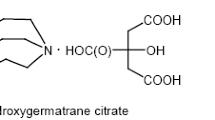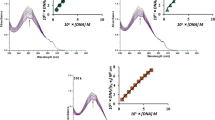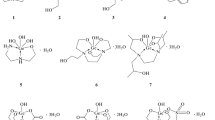Abstract
Poly-trans-[(2-carboxyethyl)germasesquioxane] (Ge-132) is a water-soluble organogermanium compound that exerts various physiological effects, including anti-inflammatory activity and pain relief. In water, Ge-132 is hydrolyzed to 3-(trihydroxygermyl)propanoic acid (THGP), which in turn is capable of interacting with cis-diol compounds through its trihydroxy group, indicating that this compound could also interact with diol-containing nucleic acid constituents. In this study, we evaluated the ability of THGP to interact with nucleosides or nucleotides via nuclear magnetic resonance (NMR) analysis. In addition, we evaluated the effect of added THGP on the enzymatic activity of adenosine deaminase (ADA) when using adenosine or 2′-deoxyadenosine as a substrate. In solution, THGP indeed formed complexes with nucleotides or nucleosides through their cis-diol group. Moreover, the ability of THGP to form complexes with nucleotides was influenced by the number of phosphate groups present on the ribose moiety. Notably, THGP also inhibited the catalysis of adenosine by ADA in a concentration-dependent manner. Thus, interactions between THGP and important biological nucleic acid constituents might be implicated in the physiological effects of Ge-132.






Similar content being viewed by others
References
Brutkiewicz RR, Suzuki F (1987) Biological activities and antitumor mechanism of an immunopotentiating organogermanium compound, Ge-132. In Vivo 1:189–203
Tsutsui M, Kakimoto N, Axtell DD, Oikawa H, Asai K (1976) Crystal structure of “carboxyethylgermanium sesquioxide.”. J Am Chem Soc 98:8287–8289
Nagata T, Nagata T, Aramaki Y, Enomoto M, Isaka H, Otsuka J (1978) Chronic intravenously toxicity study with carboxyethylgermanium sesquioxide in beagle dogs. Pharmacometrics 16:613–636
Sugiya Y, Sakamaki S, Sugita T, Abo Y, Satoh H (1986) Subacute oral toxicity of carboxyethylgermanium sesquioxide (Ge-132) in rats. Ouyou Yakuri 31:1181–1190 (in Japanese)
Miyao K, Onishi T, Asai K, Tomizawa S, Suzuki F (1980) Toxicology and phase I studies on a novel organogermanium compound, Ge-132. Curr Chemother Infect Dis 2:1527–1529
Ikemoto K, Kobayashi M, Fukumoto T, Morimatsu M, Pollard RB, Suzuki F (1996) 2-Carboxyethylgermanium sesquioxide, a synthetic organogermanium compound, as an inducer of contrasuppressor T cells. Experientia 52:159–166
Nakamura T, Saito M, Aso H (2012) Effects of a lactobacilli, oligosaccharide and organic germanium intake on the immune responses of mice. Biosci Biotechnol Biochem 76:375–377
Nakamura T, Takeda T, Tokuji Y (2015) The oral intake of organic germanium, Ge-132, elevates α-tocopherol levels in the plasma and modulates hepatic gene expression profiles to promote immune activation in mice. Int J Vitam Nutr Res 84:183–195
Aso H, Shibuya E, Suzuki F, Nakamura T, Inoue H, Ebina T, Ishida N (1985) Antitumor effect in mice of an organic germanium compound (Ge-132) when different administration methods are used. Gan To Kagaku Ryoho 12:2345–2351
Dozono H, Ikeda K, Onishi T (1996) Effectiveness of Ge-132 to relieve pain and smooth home care administration for the terminal cancer patient. Gan To Kagaku Ryoho 23(Suppl 3):291–295
Suzuki F, Brutkiewicz RR, Pollard RB (1985) Ability of sera from mice treated with Ge-132, an organic germanium compound, to inhibit experimental murine ascites tumours. Br J Cancer 52:757–763
Shimada Y, Sato K, Tokuji Y, Nakamura T (2015) Nuclear magnetic resonance studies of the interactions between the organic germanium compound Ge-132 and saccharides. Carbohydr Res 407:10–15
Nagasawa T, Sato K, Shimada Y, Kasumi T (2016) Efficient conversion of D-glucose to D-fructose in the presence of organogermanium compounds. J Appl Glycosci 63:39–45
Ataie G, Bagheri S, Divsalar A, Saboury AA, Safarian S, Namaki S, Moosavi-Movahedi AA (2007) A kinetic comparison on the inhibition of adenosine deaminase by purine drugs. Iran J Pharm Res 6:43–50
Valentine WN, Paglia DE, Clarke S, Morimoto BH, Nakatani M, Brockway R (1985) Adenine ribo- and deoxyribonucleotide metabolism in human erythrocytes, B- and T-lymphocyte cell lines, and monocyte-macrophages. Proc Natl Acad Sci U S A 82:6682–6686
Fardus-Reid F, Warren J, Le Gresley A, Malze F, Janke H, Chylla RA, Hu K, Ellinger JJ, Markley JL, Martineau E et al (2016) Validating heteronuclear 2D quantitative NMR. Anal Methods 8:2013–2019
Marschner H (1995) Mineral nutrition of higher plants. Acad Press, pp 379–396
Kim DH, Faull KF, Norris AJ, Eckhert CD (2004) Borate-nucleotide complex formation depends on charge and phosphorylation state. J Mass Spectrom 39:743–751
Chen CC, Akopian AN, Sivilotti L, Colquhoun D, Burnstock G, Wood JN (1995) A P2X purinoceptor expressed by a subset of sensory neurons. Nature 377:428–431
Inoue K, Tsuda M, Koizumi S (2005) ATP receptors in pain sensation: involvement of spinal microglia and P2X(4) receptors. Purinergic Signal 1:95–100
Hide I, Tanaka M, Inoue A, Nakajima K, Kohsaka S, Inoue K, Nakata Y (2000) Extracellular ATP triggers tumor necrosis factor-α release from rat microglia. J Neurochem 75:965–972
Cook SP, McCleskey EW (2002) Cell damage excites nociceptors through release of cytosolic ATP. Pain 95:41–47
Koizumi S, Fujishita K, Inoue K, Shigemoto-Mogami Y, Tsuda M, Inoue K (2004) Ca2+ waves in keratinocytes are transmitted to sensory neurons: the involvement of extracellular ATP and P2Y2 receptor activation. Biochem J 380:329–338
Nakamura T, Shimada Y, Takeda T, Sato K, Akiba M, Fukaya H (2015) Organogermanium compound, Ge-132, forms complexes with adrenaline, ATP and other physiological cis-diol compounds. Future Med Chem 7:1233–1246
Yegutkin GG (2008) Nucleotide- and nucleoside-converting ectoenzymes: important modulators of purinergic signalling cascade. Biochim Biophys Acta - Mol Cell Res 1783:673–694
Belfrage M, Sollevi A, Segerdahl M, Sjölund KF, Hansson P (1995) Systemic adenosine infusion alleviates spontaneous and stimulus evoked pain in patients with peripheral neuropathic pain. Anesth Analg 81:713–717
Montesinos MC, Desai A, Delano D, Chen JF, Fink JS, Jacobson MA, Cronstein BN (2003) Adenosine A2A or A3 receptors are required for inhibition of inflammation by methotrexate and its analog MX-68. Arthritis Rheum 48:240–247
Takagi H, Sato H, Nakayama Y, Kawaguti S (1983) Analgesic activity of organogermanium compound Ge-132. Jpn J Med Pharm Sci 10:153–157 (in Japanese)
Suzuki Y, Taguchi K (1983) Pharmacological studies of carboxyethylgermanium sesquioxide (Ge-132) (1). Pharmacometrics 26:803–810 (in Japanese)
Hachisu M, Takahashi H, Koeda T, Sekizawa Y (1983) Analgesic effect of novel organogermanium compound, GE-132. J Pharmacobiodyn 6:814–820
Ueda T (1999) The effect of adenosin A1 fiber for nitrous oxide-and/or morphine induced Analges. Kyushu-Shika-Gakkai-zasshi 53:677–686 (in Japanese)
Yashpal K, Henry JL (1992) Adenosine receptor link in an adrenal opioid-induced antinociception in the rat tail-flick test. Neurosci Lett 138:253–256
Lavand’homme PM, Eisenach JC (1999) Exogenous and endogenous adenosine enhance the spinal antiallodynic effects of morphine in a rat model of neuropathic pain. Pain 80:31–36
Peart JN, Gross GJ (2003) Adenosine and opioid receptor-mediated cardioprotection in the rat: evidence for cross-talk between receptors. Am J Physiol Heart Circ Physiol 285:H81–H89
Gross ER, Gross GJ (2006) Ligand triggers of classical preconditioning and postconditioning. Cardiovasc Res 70:212–221
Tanaka K, Kersten JR, Riess ML (2014) Opioid-induced cardioprotection. Curr Pharm Des 20:5696–5705
Chen JF, Eltzschig HK, Fredholm BB (2013) Adenosine receptors as drug targets—what are the challenges? Nat Rev Drug Discov 12:265–286
Barankiewicz J, Danks AM, Abushanab E, Makings L, Wiemann T, Wallis RA, Pragnacharyulu PV, Fox A, Marangos PJ (1997) Regulation of adenosine concentration and cytoprotective effects of novel reversible adenosine deaminase inhibitors. J Pharmacol Exp Ther 283:1230–1238
Meuwissen HJ, Pollara B, Pickering RJ (1975) Combined immunodeficiency disease associated with adenosine deaminase deficiency. Report on a workshop held in Albany, New York, October 1, 1973. J Pediatr 86:169–181
Begleiter A, Pugh L, Israels LG, Johnston JB (1988) Enhanced cytotoxicity and inhibition of DNA damage repair in irradiated murine L5178Y lymphoblasts and human chronic lymphocytic leukemia cells treated with 2′-deoxycoformycin and deoxyadenosine in vitro. Cancer Res 48:3981–3986
Bagnara AS, Hershfield MS (1982) Mechanism of deoxyadenosine-induced catabolism of adenine ribonucleotides in adenosine deaminase-inhibited human T lymphoblastoid cells. Proc Natl Acad Sci U S A 79:2673–2677
Acknowledgements
The authors want to thank K. Sakamoto (Hirosaki University) for his invaluable advice concerning the enzyme assay. We also thank H. Maeda (Hirosaki University) for his constructive comments. We did not receive any external funding or grants in support of this research.
Author information
Authors and Affiliations
Corresponding author
Ethics declarations
Conflict of Interest
The authors declare that they have no competing interests.
Rights and permissions
About this article
Cite this article
Shimada, Y., Sato, K., Takeda, T. et al. The Organogermanium Compound Ge-132 Interacts with Nucleic Acid Components and Inhibits the Catalysis of Adenosine Substrate by Adenosine Deaminase. Biol Trace Elem Res 181, 164–172 (2018). https://doi.org/10.1007/s12011-017-1020-4
Received:
Accepted:
Published:
Issue Date:
DOI: https://doi.org/10.1007/s12011-017-1020-4




